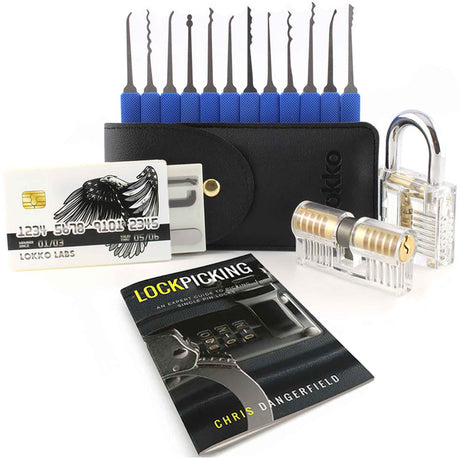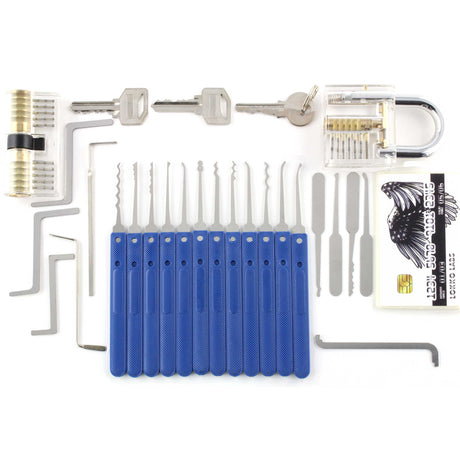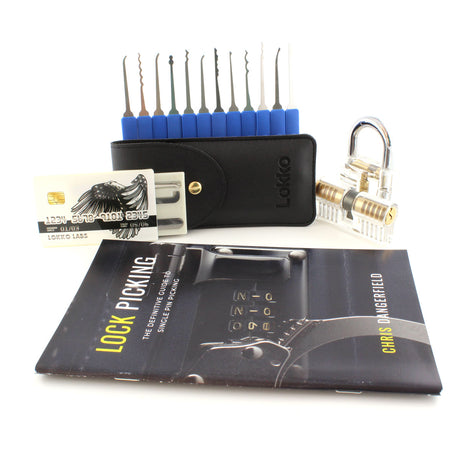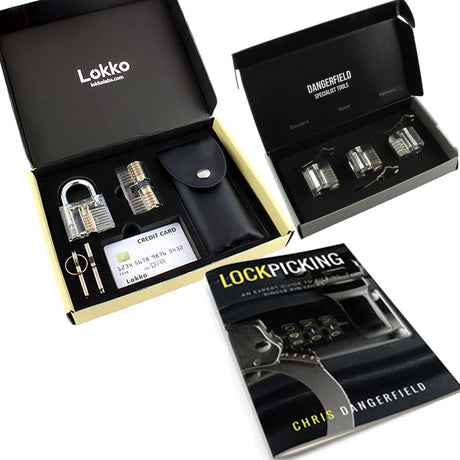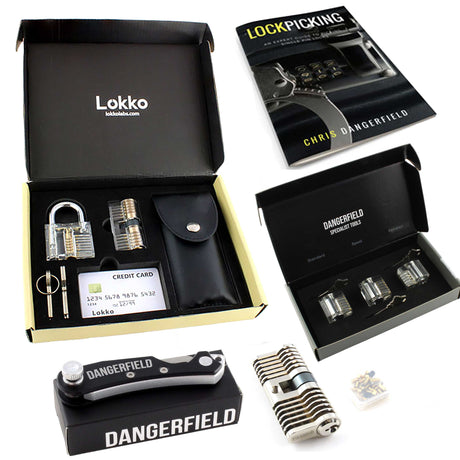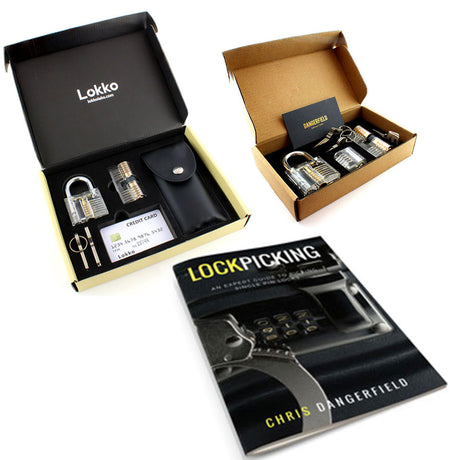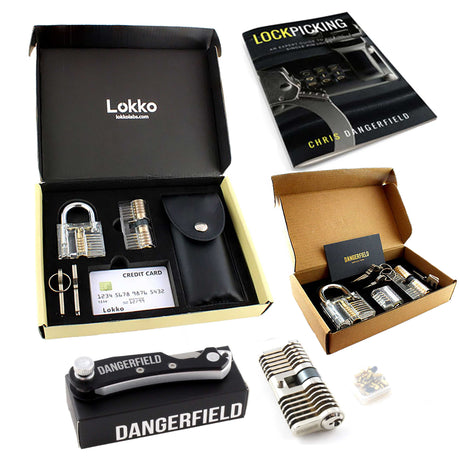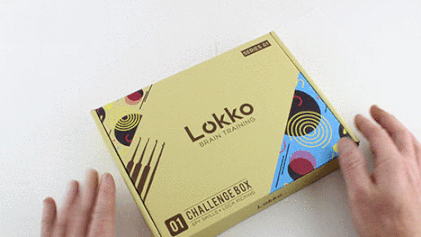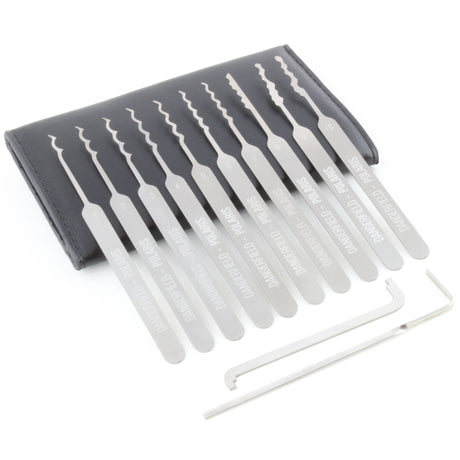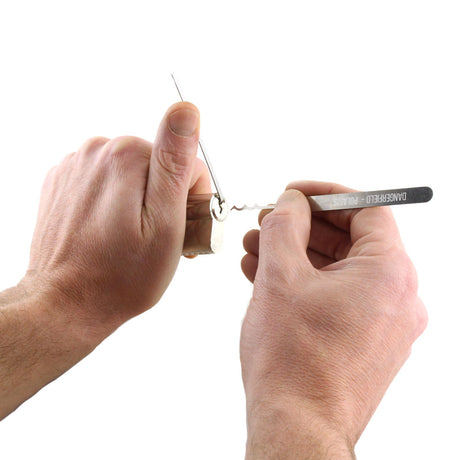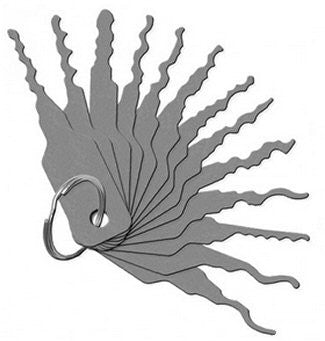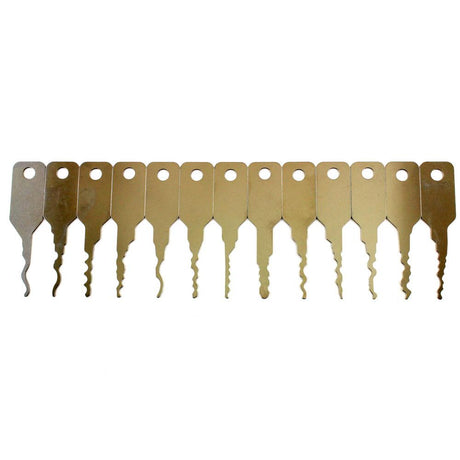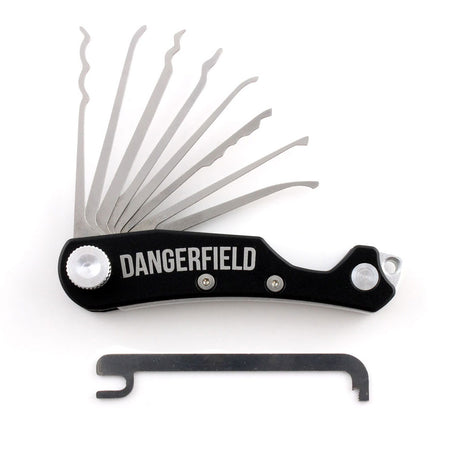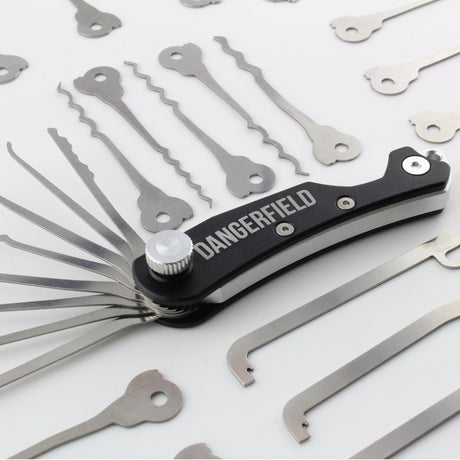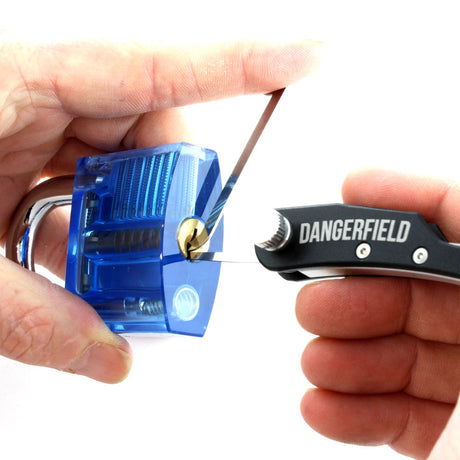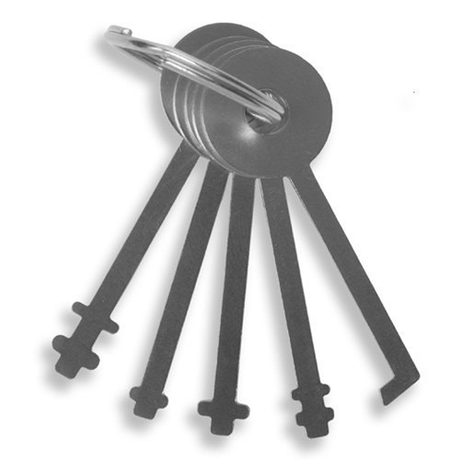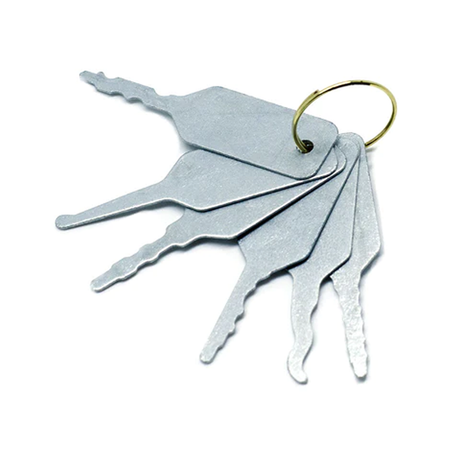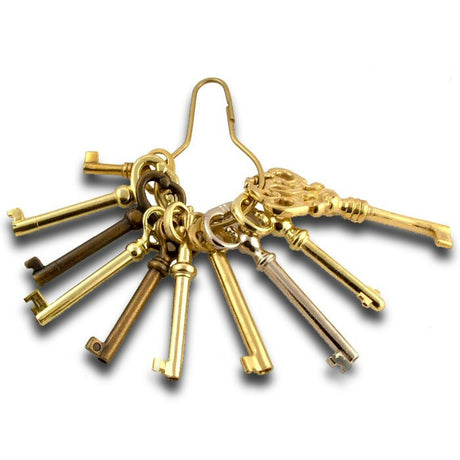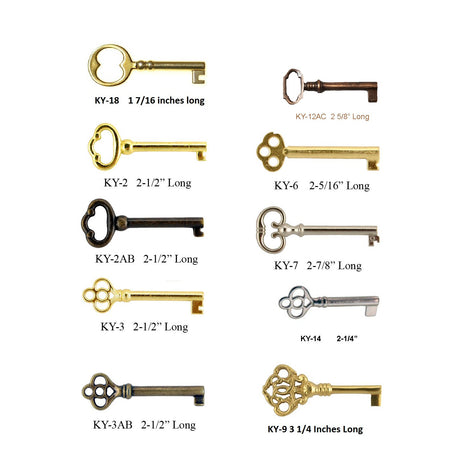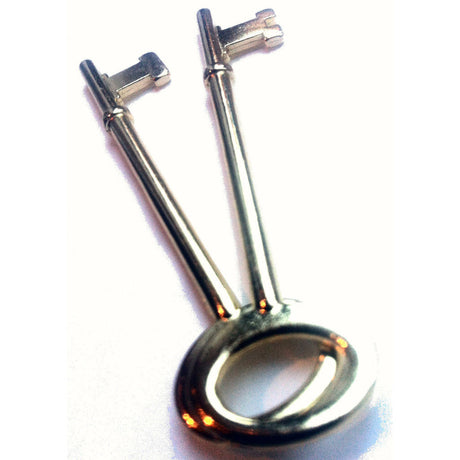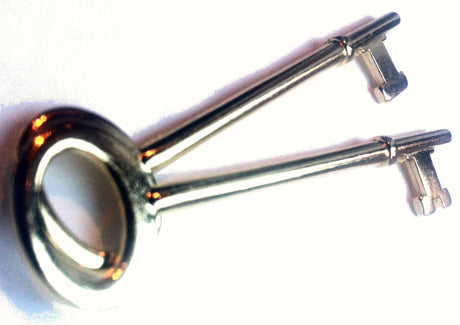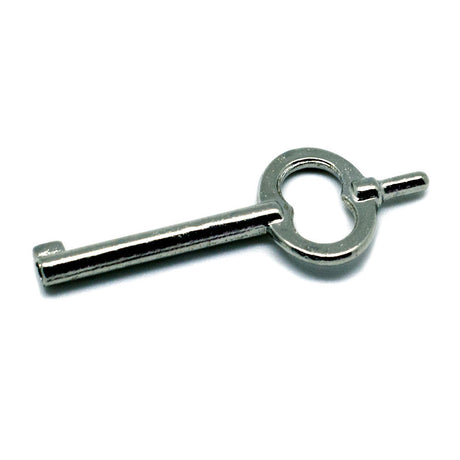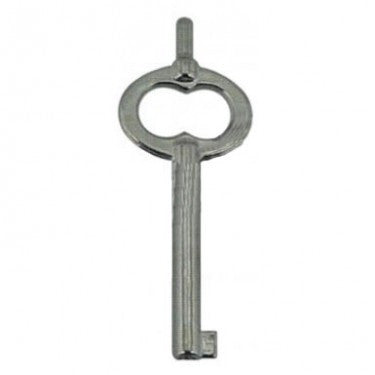Skeleton Keys - Lock Picking Multi-tool
(9 products)Perhaps no other lock-picking tool is surrounded in as much mystique as skeleton keys. They crop up in literature and in movies all the time. Some people even collect antique skeleton keys But what are skeleton keys? And how do you use them?
Skeleton keys are keys designed to open more than one lock. A normal key tends to fit one lock, and that is that, but skeleton keys are designed to unlock many locks of its type. With various techniques and clever manufacturing, skeleton keys will help any beginner wishing to learn how to pick locks and the professional who needs to open a wide range of locks in their daily work.
Skeleton keys do not require a tension tool. Skeleton keys offer you, the lock picker, another excellent technique to add to your repertoire. That’s why locksmiths have a variety of tools for each lock type—to ensure entry when it’s essential. We have a great range of options that we consider skeleton keys, including many exclusives, designed and manufactured by us. Have you got any in your closet?
You’ll notice that we have included the Polaris Rake set in this collection. That’s because even professional locksmiths recommend it to get through many, many different types of brass, stainless steel, and other metal locks. It comes with a guide for “raking,” which is a style of picking that is extra effective and a great addition to normal picking.
Additionally, I’ve taken the liberty of adding our Lokko Beginners Lock Pick Set. This set does exactly what you expect, and it is a great learning tool if you are looking for an entry-level tool similar to skeleton keys.
More about Skeleton Keys
I get more requests for information about skeleton keys than anything else. Google logs skeleton keys as one of the most popular lock-picking products regularly searched for. Say “lock picking” to anyone, and most people will be aware of these legendary antique skeleton keys.
Although most know the concept of skeleton keys, they’ll have little or no idea of what a skeleton key is. In truth, skeleton keys are not that simple. So, I decided it’s time to set the record straight and once and for all explain as best I can the truth about skeleton keys.
A long time ago, in the days of very simple and antique warded locks, all you needed to unlock them was to bypass the wards, engage the cam at the end of the barrel, and turn. The lock would then open. The reason this worked is because those locks were already unlocked, so to speak, and the wards merely provided an obstruction. Skeleton keys were known as such since these had been ground down to the bare bones, their serrated edges removed. This diagram shows you the right key for the lock and the skeleton key made out of that key. And although it’s a modern lock, the principle is much the same.

A key for a warded lock and an identical key, no serrated edge and ground down to its “bare bones.”
If you look at the following diagram, you’ll see how antique warded locks function and how making skeleton keys in the above manner would allow the key to go straight through to the back of the lock and turn the cam. Unlike other locks (with the exception of thumb-turn Euro locks, which are terribly bad security for this reason), the lock isn’t actually locked. There’s nothing stopping the barrel from turning if you can get to the back of the lock.

A warded lock. See how the removal of the wards allows the key to get to the back of the lock and engage the cam.
Other locks, thankfully, don’t have this ridiculous vulnerability and therefore are not vulnerable to being exploited in this manner. Lever locks, pin cylinders, disc detainers, and others contain some sort of design where the turning of the lock is blocked, so the cam won’t turn unless the obstructions are removed; this process requires one key with the correct combination of depths cut into it.
A pin cylinder, for example, moves the series of split-pin stacks so as to line up the split along the edge of the barrel (the shearline), allowing it to turn. (See diagram below.) A lever (mortice) lock has a series of gates that prevent the stump from moving. The stump is connected to the bolt. If the stump can’t move, the bolt can’t move.
The gates all have a little gap in them, all in different places. A normal key with the correct combination of depths will align all these gaps, allowing the stump and therefore the bolt, to move, thus opening the lock.
Tubular and dimple locks are really just slight variants of pin-cylinder locks. A dimple lock has the key turned 90 degrees, and a tubular lock has the series of pins in a circle, neither of which adds much security but rather a bit of novelty, which the market always appreciates.

The split between the pins needs to run along where the cylinder meets the housing. Then the cylinder can turn.
The bottom line is, there are no such things as skeleton keys, old or new, for these locks. You cannot remove a key’s serrated edge, down to the bare bones; bypass the gates or pins; and turn the cam. It simply isn’t possible. All day, every day, we receive emails asking for skeleton keys. Research, experience, and speaking to people have shown us that what people really want are master keys, or any similar tool, that will unlock many locks of the same type.
Thankfully, such tools do exist, and although they’re not strictly skeleton keys, the result is the same. Master the technique, and you will have access to many locks of the same type with the one tool or key.
Here’s a brief description of a series of such tools, many of which we supply. They are differentiated from picks and rakes since they do not require a separate tension tool. If you want more information (and frequently, a video), click on the links and see them in our shop.
Bump Keys
Bump keys, in one form or another, have been around for decades. In fact, a patent for a bump key-like tool with a spring-like feature was lodged way back in 1928 by an H. R. Simpson.
However, it wasn’t until the early 2000s that the “bump pattern” was perfected (by me). The tip was shortened, the shoulder removed, and a dampener added. These developments are what caused the bump key explosion to happen, as they really grew in effectiveness and (with the help of a paranoid, fear-mongering campaign by the media) popularity.

I took off the shoulder and a bit of the tip then added some dampeners. This turned an okayish lock-picking tool into one that can open a lock in seconds. Most locksmiths today will have a selection in their arsenal.
As much as a bump key will open many locks of the same type (if the profile of the key fits the keyway), we can bracket these under skeleton keys. The skeleton key type of tool is struck with a bump hammer or an improvised device such as a screwdriver, and the special zig-zag pattern on the key transmits the energy through the bottom pins, causing the top pins to jump. The key is turned right at the point of striking, meaning if successful, the pins will clear the shearline, allowing the plug to turn and the lock to open.
I made my name in the lock-picking world with bump keys, and a well-made one can unlock around 80% of the locks the original blank was designed for. No lock-picking tool is 100% effective, so those numbers are great. Being a proficient lock picker is about having a repertoire of tools, so if one doesn’t work, another might. Even a cheap and simple lock might withstand an electric pick gun, but it might be vulnerable to a bump key. That’s just how it goes.

Tubular Picks (See in Shop)

Rake Keys (See in Shop)
Rake keys are perhaps most similar to what people assume a skeleton key is. The untrained eye could easily confuse them for a normal key, although they have special patterns cut onto them which have been researched and tested to provide the most success opening locks.
These skeleton-key-like options are named rake keys after the “rakelock-pickingng tool, but they’re different since they do not require a tension wrench. While the key is moved in and out of the lock, it is also occasionally turned slightly, causing a tiny ledge to form along the shearline. Any pins that have been lifted to the “correct” height will then sit on that ledge. Once all the pins are on the ledge, the lock is free to open. This is a great tool for beginners since the grooves on the key make sure the tool is inserted at the right height to correctly ’pick’ the lock.
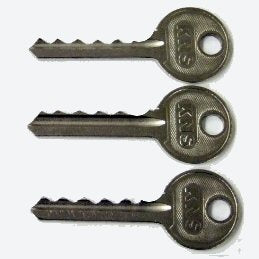
Master keys (See in Shop)
There are two types of master keys: skeleton keys and the non-skeleton keys. One type of master key is concerned with groups of locks that require both an individual key for each lock and another single key for all of them, such as for a hotel or a locker room. The other is a master key where the locks are the same wherever they appear, meaning the same master key will always unlock them.
The former master key type doesn’t count as a skeleton key-type tool, whereas the latter could be considered skeleton keys. A good example of such a master key is the FB keys, or fire brigade keys, used to lock communal doors and roadblocks and used by firemen who need access in emergencies. There are other master keys, which I suggest you see in the shop for more information.

Jigglers (See in Shop)
Apart from offering all manner of double entendres, jigglers have established themselves as must-have items for locksmiths the world over. Like a cross between a rake and a tension tool, jigglers are a single-item tool great for beginners and professionals alike. This is mainly due to their ease of use. The jiggler is inserted into the lock and jiggled about!

A set of auto-jigglers for vehicles with wafer locks.
The most well-known jigglers are the mini, medium, and auto jigglers. So most wafer locks (such as desks, cabinets, postal boxes, etc.) right through to the nearly antique-style car locks (“auto” here means vehicle) have a jiggler for the job!Just as we’d all assumed, only wafer locks could be jiggled. Lock-picking giants SouthOrd developed the first pin-cylinder jigglers a few years ago, and it took the lock-picking world by storm. A short video released by a SouthOrd employee of the jigglers making easy work of three locks piqued the interest of lock pickers everywhere, and soon everyone had a set. In fact, I’d say out of all the items in this article, the SouthOrd Pin-Cylinder Jigglers are the most likely contender for a tool that represents what most people would consider as skeleton keys.

The “must-have” SouthOrd 13-piece Pin Cylinder Jigglers
You insert the key into any pin-cylinder lock it will fit (which is, happily, the majority) and jiggle the key. Jiggling takes many forms. The key can go in and out of the lock, like a rake; it can make use of the small amount of vertical space in a lock and be moved up and down, and it can be “vibrated” (or, as one prominent lock picking blogger put it, “held onto as if I’d had far too much coffee”).
Predictably, it’s a combination of all these movements that gives the best results, and I have to say they’re amazing. Since there’s no tension tool, you must also remember to apply a small amount of turning pressure, allowing the pins (or wafers) to set.
As I’ve said before, everyone may already know how to use jigglers, since we’ve all had worn locks before and had to give the correct key a wiggle and a jiggle to get it working. The pin-cylinder jigglers are one of my all-time favourite lock-picking tools—a must-have. In fact, SouthOrd can’t produce enough of these. We’re constantly upping our orders and continually having to wait. If you want some, and they’re not in stock, click the “Email When Available” tab on the product page to ensure you’re notified when the item is back in stock
Try-out keys (See in Shop)
Try-out keys are one of the most antique tools that can be considered similar to skeleton keys, although this is probably due to the age of lever locks than anything else. They’ve been around for centuries in one form or another. Try-out keys work on the principle that there are many “typical” key patterns for lever locks. When the lock has two or three levers, the possibilities are even less. Add to this, the fact these locks wear with age and the tolerances reduced, try-out keys are a pretty good bet.

A typical set of 2 lever try-out keys.
Although distinct from a jiggler, it’s not uncommon to give a try-out key a little jiggle here and a wobble there. A small amount of movement might turn a slightly low cut into the desired height. Old and worn locks can be exploited in this way. Coming in sets of usually between 10 and 20, it makes sense to have a set or two.
Although it’s rare for people to secure their homes with anything less than a five-lever lock, many internal doors have two- and three-lever locks, and being able to unlock these without drilling can save valuable time and hassle. Although a quantity of try-out keys is required to up the odds in your favour, I think these still count as skeleton keys since one key will have the ability to open many locks in its group.
Conclusion
With the different types of locks in use today, it’s not surprising there’s a multitude of contenders for anything similar to skeleton keys. As technology progresses and locks develop—from iris-activated locks, fingerprint locks, and even locks you unlock with your phone—I’m confident lock-picking innovations will continue alongside these developments, continuing to both confuse the issue of what skeleton keys are whilst offering us more and more interesting items to pursue this wonderful art of ours.
One day, in the distant future, I see someone removing a capsule from their pocket and pouring dust into a lock. That dust, or more of a gray sludge, is composed of a million tiny nanorobots, each programmed to pick the lock from the inside. Or who knows, maybe in the future, we’ll live forever, and people will have forgotten all about the antique skeleton keys altogether. In the meantime, if you’re ever asked about skeleton keys, you can say, “Yes, they do exist. Sort of.”

- Featured
- Best selling
- Alphabetically, A-Z
- Alphabetically, Z-A
- Price, low to high
- Price, high to low
- Date, old to new
- Date, new to old
FiltersFilter & Sort
Lock Pick Set - Complete for Beginners: Lock Picks, Practice Locks, Covert Kit + How-to Guide
Most Beginner Friendly Kit
★★★★★(851)From $49.99$75.00Unit price /UnavailableDangerfield Polaris Rakes - the #1 lock picking rake set
★★★★★(97)$79.99$99.95Unit price /UnavailableSKELETON EDC Multi Tool Lock Pick Set - by Dangerfield
The Leatherman of Lock Picks
★★★★★(49)From $44.99$64.99Unit price /UnavailableWarded Lock Pick Set - for Lockers, Padlocks, Cabinets + more
★★★★★(20)$18.99$19.99Unit price /Unavailable

